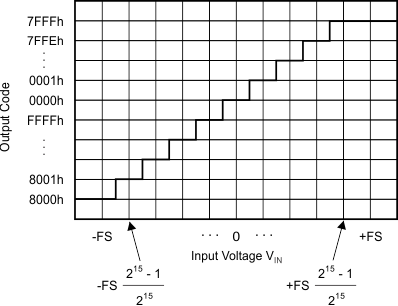SBAS444D May 2009 – January 2018 ADS1113 , ADS1114 , ADS1115
PRODUCTION DATA.
- 1 Features
- 2 Applications
- 3 Description
- 4 Revision History
- 5 Device Comparison Table
- 6 Pin Configuration and Functions
- 7 Specifications
- 8 Parameter Measurement Information
-
9 Detailed Description
- 9.1 Overview
- 9.2 Functional Block Diagrams
- 9.3 Feature Description
- 9.4 Device Functional Modes
- 9.5 Programming
- 9.6 Register Map
-
10Application and Implementation
- 10.1 Application Information
- 10.2
Typical Application
- 10.2.1 Design Requirements
- 10.2.2
Detailed Design Procedure
- 10.2.2.1 Shunt Resistor Considerations
- 10.2.2.2 Operational Amplifier Considerations
- 10.2.2.3 ADC Input Common-Mode Considerations
- 10.2.2.4 Resistor (R1, R2, R3, R4) Considerations
- 10.2.2.5 Noise and Input Impedance Considerations
- 10.2.2.6 First-order RC Filter Considerations
- 10.2.2.7 Circuit Implementation
- 10.2.2.8 Results Summary
- 10.2.3 Application Curves
- 11Power Supply Recommendations
- 12Layout
- 13Device and Documentation Support
- 14Mechanical, Packaging, and Orderable Information
Package Options
Mechanical Data (Package|Pins)
Thermal pad, mechanical data (Package|Pins)
Orderable Information
9.5.4 Data Format
The ADS111x provide 16 bits of data in binary two's complement format. A positive full-scale (+FS) input produces an output code of 7FFFh and a negative full-scale (–FS) input produces an output code of 8000h. The output clips at these codes for signals that exceed full-scale. Table 5 summarizes the ideal output codes for different input signals. Figure 33 shows code transitions versus input voltage.
Table 5. Input Signal Versus Ideal Output Code
| INPUT SIGNAL
VIN = (VAINP – VAINN) |
IDEAL OUTPUT CODE(1)(1) |
|---|---|
| ≥ +FS (215 – 1)/215 | 7FFFh |
| +FS/215 | 0001h |
| 0 | 0000h |
| –FS/215 | FFFFh |
| ≤ –FS | 8000h |
 Figure 33. Code Transition Diagram
Figure 33. Code Transition Diagram
NOTE
Single-ended signal measurements, where VAINN = 0 V and VAINP = 0 V to +FS, only use the positive code range from 0000h to 7FFFh. However, because of device offset, the ADS111x can still output negative codes in case VAINP is close to 0 V.